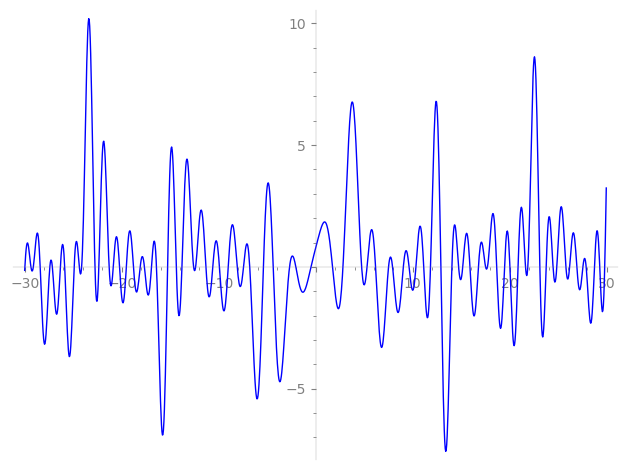| L(s) = 1 | + (−1.22 − 0.704i)2-s − i·3-s + (1.00 + 1.72i)4-s + 5-s + (−0.704 + 1.22i)6-s + (2.37 − 1.16i)7-s + (−0.0147 − 2.82i)8-s − 9-s + (−1.22 − 0.704i)10-s − 2.29·11-s + (1.72 − 1.00i)12-s − 6.22·13-s + (−3.73 − 0.247i)14-s − i·15-s + (−1.97 + 3.47i)16-s − 2.99i·17-s + ⋯ |
| L(s) = 1 | + (−0.866 − 0.498i)2-s − 0.577i·3-s + (0.503 + 0.864i)4-s + 0.447·5-s + (−0.287 + 0.500i)6-s + (0.898 − 0.439i)7-s + (−0.00520 − 0.999i)8-s − 0.333·9-s + (−0.387 − 0.222i)10-s − 0.692·11-s + (0.498 − 0.290i)12-s − 1.72·13-s + (−0.997 − 0.0662i)14-s − 0.258i·15-s + (−0.493 + 0.869i)16-s − 0.725i·17-s + ⋯ |
\[\begin{aligned}\Lambda(s)=\mathstrut & 840 ^{s/2} \, \Gamma_{\C}(s) \, L(s)\cr =\mathstrut & (-0.895 + 0.444i)\, \overline{\Lambda}(2-s) \end{aligned}\]
\[\begin{aligned}\Lambda(s)=\mathstrut & 840 ^{s/2} \, \Gamma_{\C}(s+1/2) \, L(s)\cr =\mathstrut & (-0.895 + 0.444i)\, \overline{\Lambda}(1-s) \end{aligned}\]
Particular Values
| \(L(1)\) |
\(\approx\) |
\(0.180623 - 0.770069i\) |
| \(L(\frac12)\) |
\(\approx\) |
\(0.180623 - 0.770069i\) |
| \(L(\frac{3}{2})\) |
|
not available |
| \(L(1)\) |
|
not available |
\(L(s) = \displaystyle \prod_{p} F_p(p^{-s})^{-1} \)
| $p$ | $F_p(T)$ |
|---|
| bad | 2 | \( 1 + (1.22 + 0.704i)T \) |
| 3 | \( 1 + iT \) |
| 5 | \( 1 - T \) |
| 7 | \( 1 + (-2.37 + 1.16i)T \) |
| good | 11 | \( 1 + 2.29T + 11T^{2} \) |
| 13 | \( 1 + 6.22T + 13T^{2} \) |
| 17 | \( 1 + 2.99iT - 17T^{2} \) |
| 19 | \( 1 - 0.901iT - 19T^{2} \) |
| 23 | \( 1 + 8.15iT - 23T^{2} \) |
| 29 | \( 1 + 1.15iT - 29T^{2} \) |
| 31 | \( 1 + 1.82T + 31T^{2} \) |
| 37 | \( 1 + 1.80iT - 37T^{2} \) |
| 41 | \( 1 + 11.3iT - 41T^{2} \) |
| 43 | \( 1 - 11.5T + 43T^{2} \) |
| 47 | \( 1 + 9.48T + 47T^{2} \) |
| 53 | \( 1 + 4.44iT - 53T^{2} \) |
| 59 | \( 1 - 5.71iT - 59T^{2} \) |
| 61 | \( 1 + 11.0T + 61T^{2} \) |
| 67 | \( 1 - 6.42T + 67T^{2} \) |
| 71 | \( 1 + 7.96iT - 71T^{2} \) |
| 73 | \( 1 - 4.10iT - 73T^{2} \) |
| 79 | \( 1 - 14.9iT - 79T^{2} \) |
| 83 | \( 1 - 10.3iT - 83T^{2} \) |
| 89 | \( 1 + 1.36iT - 89T^{2} \) |
| 97 | \( 1 + 8.12iT - 97T^{2} \) |
| show more | |
| show less | |
\(L(s) = \displaystyle\prod_p \ \prod_{j=1}^{2} (1 - \alpha_{j,p}\, p^{-s})^{-1}\)
Imaginary part of the first few zeros on the critical line
−9.925802265203422048598228378341, −9.022170541319643931970585732931, −8.092725259566945418874552950899, −7.44412856536555551801443141080, −6.80243473309690460417635323286, −5.39360603864912891436869102708, −4.38631995064271537387089649732, −2.69769137098185960528163323457, −2.04813421056610577585799843548, −0.48581909924306731004743807406,
1.72990098847475118329851531203, 2.80611035837287958047696333781, 4.73304845418907089546419934129, 5.28873956748407686797983172203, 6.16640004477817022957935157899, 7.50639305689490629221911778573, 7.921763157684776883286360157363, 9.030943435021351412965069719735, 9.622552563947609966009862901313, 10.32687135910707858297144100994

